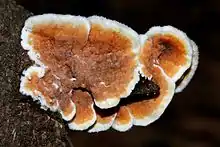| Gloeoporus dichrous | |
|---|---|
 | |
| Scientific classification | |
| Domain: | Eukaryota |
| Kingdom: | Fungi |
| Division: | Basidiomycota |
| Class: | Agaricomycetes |
| Order: | Polyporales |
| Family: | Irpicaceae |
| Genus: | Gloeoporus |
| Species: | G. dichrous |
| Binomial name | |
| Gloeoporus dichrous | |
| Synonyms | |
| |
Gloeoporus dichrous is a species of fungus in the family Irpicaceae. First described as Polyporus dichrous by Elias Magnus Fries in 1815, it was later transferred to the genus Gloeoporus by Italian mycologist Giacomo Bresadola in 1912.[1] The variety G. dichrous var. niger (formerly known as Ceriporiopsis nigra) was proposed in 2008, after molecular analysis revealed the two taxa were conspecific.[2] G. dichrous is inedible.[3]
References
- ↑ Bresadola, G. (1913). "Basidiomycetes philippinenses. Series II". Hedwigia. 53: 44–80.
- ↑ Tomšovský, M.; Ryvarden, L. (2008). "Gloeoporus dichrous var. niger comb. nov". Mycotaxon. 105: 171–174.
- ↑ Phillips, Roger (2010). Mushrooms and Other Fungi of North America. Buffalo, NY: Firefly Books. p. 318. ISBN 978-1-55407-651-2.
This article is issued from Wikipedia. The text is licensed under Creative Commons - Attribution - Sharealike. Additional terms may apply for the media files.